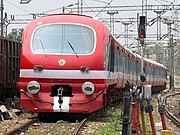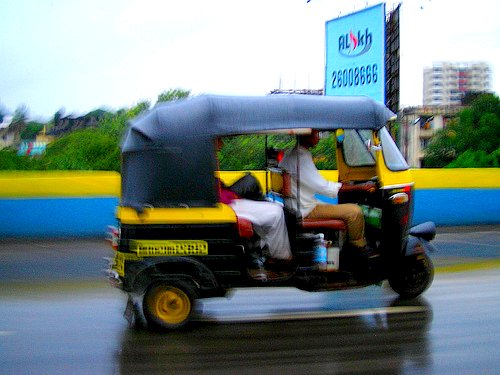
Road transport in India has a large and extensive transportation system. The country has one of the world's largest railway and roadway network transporting millions of people every year. However, vast sections of the country's transportation network remains underdeveloped. Horse Carriages Advent of the British saw drastic improvements in the horse carriages which were used for transport since early days. Till today they are used in smaller towns and are referred as "Tanga" and buggies (Victorias of Bombay) are still used for toursit purposes |
Cycle Rickshaw
From the early part of the century the bicycle rickshaws also became popular and are still used in rural India . Its more a bigger tri-cycle wherein two people can sit on a elavated seat at the back and a person will paddle (driver) from the front. In urban areas they have been mostly superseded by auto rickshaws.
Manually Pulled Rickshaw
This type of transport was prevalent until 2005 in Kolkata wherein a person pulls the rickshaw. The Government of West Bengal banned these rickshaw in 2005 describing them "inhuman". While this was lauded in general but questions about alternative means of livelihood of those who directly or indirectly depend on hand pulled rickshaws were not immediately addressed.
Trams
The advent of the British saw trams being introduced in many cities including Mumbai and Calcutta . They are still in use in Calcutta and provide a pollution-free means of transportation. The nationalised Calcutta Tram Company has introduced buses on certain routes in order to generate more revenue and reduce losses.
Local transport
Local transportation is predominantly by road, with a small fraction (depending on the city) by trains. Most Indian cities are connected to surrounding towns by buses or trains. The vast national rail network also enables farmers to transport their farm and agriculture produce to larger towns, where they get better prices.
The roads in most cities are poorly maintained and full of potholes, while in villages they are frequently non-existent. Traffic generally moves slowly and erratically, and traffic jams and accidents are very common. AReader's Digest study of traffic congestion in Asian cities ranked several Indian cities within the Top Ten for worst traffic.
Buses
Buses are very cheap in most cities but also very crowded and have unpredictable timings, frequently necessitating long waits. In the big cities and towns of India , buses are the major mode of transport. Luxury and air-conditioned buses also service some cities. Most means of transportation within cities is run by the government. Buses are categorised, based upon the number of seats, the time it takes to travel from A to B, and general comfort. Express and limited buses are usually more expensive options compared to the normal ones, the latter being increasingly modern whilst cheap and easily accessible.
Vans
Vans or Mini-Buses is a more prevalent form of transportation especially in remote areas and common route with consistent yet small transportation needs. Not to mention it's presence in other cities,where it is often a traffice menace.
Autorickshaws
An auto rickshaw (auto or rickshaw or tempo in popular parlance) is a three-wheeler vehicle for hire. They typically have no doors or seatbelts. They are generally yellow or green in colour and have a black canopy on the top. An auto rickshaw is generally characterized by a tin/iron body resting on three small wheels (one in front, two on the rear), a small cabin for the driver in the front and seating for three in the rear. Their design varies considerably from place to place. In some locations, they have an extra plank on the seat to accommodate a fourth passenger. Hiring an auto often involves bargaining with the driver.
In some cities like New Delhi , there are larger autos called Fat-fat, which is an onomatopoeic derivation of the phut-phut crackle of their exhausts. These run on fixed routes on fixed fares and are very fuel efficient. Only six passengers are allowed legally but they usually take as many as ten adults. These autos are the new incarnation of old Fat-fats, which were Harley-Davidson and similar powerful motorcycles modified by removing the rear wheel and bolting a two-wheeled platform with bench seats onto the rear.
Two-wheelers
Two wheelers are the most popular mode of transport in terms of number of vehicles. There are two main types of powered two-wheelers, themotor scooter and themotorcycle
The scooter was first built in post-war Italy as a two-wheeler with small wheels (supposedly to utilize war-surplus aircraft tail wheels). It differs from the motorcycle in having the driver seated with his legs together, and is thus favoured by women drivers (assari, a common Indian dress for women, doesn't permit separation of legs). The Italian Vespa scooter was built in India under license by Bajaj Auto, and together with the Italian Lambretta scooter dominated the two-wheeler scene. Much later came the hugely successful Bajaj Chetak scooter, but Bajaj has since lost the market to new entrants like Kinetic Motors. In the past decade, lightweight mini-scooters like the TVS Scooty and the Honda Activa have made it much easier for women to travel.
The post-war years saw the predominance of foreign motorcycles, mainly British ones like Norton, BSA, Ariel etc. In the 1960s Indian-made bikes like Royal Enfield Bullet (a 350cc British design), Jawa (a 250cc Czech design) and Rajdoot (a 175cc Polish design) predominated. After the beginning of liberalization Indian versions of popular Japanese bikes such as Suzuki, Honda, Kawasaki and Yamaha hit the roads, leading to motorcycles outstripping scooters in popularity. The overwhelmingly large number of bikes sold have engines 175cc or less.
Cars
The demand for cars in India is one of the highest in the world. In2002 more than 50,000 new cars were brought in Delhi alone. Compact cars predominate due to low cost.Maruti, Hyundai, Tata Motors and Ford are the most popular brands in the order of their market share. The clunky Ambassador once had a monopoly but is now an icon of pre-liberalization India , and is still used by politicians.Maruti 800 launched in1984 created the first revolution in the Indian auto sector because of its low pricing. It had the highest market share until 2004, when it was overtaken by other low cost models of Maruti and those of foreign entrants like Hyundai. Over the 20 year period since its introduction about 2.4 milion units of Maruti 800 have been sold.















